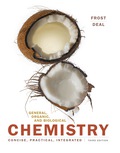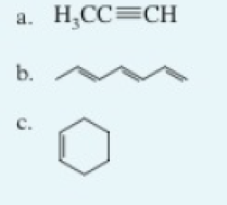
EBK GENERAL, ORGANIC, AND BIOLOGICAL CH
3rd Edition
ISBN: 8220101460288
Author: Deal
Publisher: PEARSON
expand_more
expand_more
format_list_bulleted
Concept explainers
Textbook Question
Chapter 4, Problem 4.17PP
Identify the family of hydrocarbon present in the following:

Expert Solution & Answer
Want to see the full answer?
Check out a sample textbook solution
Students have asked these similar questions
When propionic aldehyde in vapor form at 200 mmHg and 30°C is irradiated with radiation of wavelength 302 nm, the quantum yield with respect to the formation of CO is 0.54. If the intensity of the incident radiation is 1.5x10-3 W, find the rate of formation of CO.
Draw mechanism
Does Avogadro's number have units?
Chapter 4 Solutions
EBK GENERAL, ORGANIC, AND BIOLOGICAL CH
Ch. 4 - Prob. 4.1PPCh. 4 - Prob. 4.2PPCh. 4 - Prob. 4.3PPCh. 4 - Draw a skeletal structure for ethane, C2H6. Do you...Ch. 4 - Prob. 4.5PPCh. 4 - Prob. 4.6PPCh. 4 - Draw a Lewis structure for each of the following...Ch. 4 - Draw a Lewis structure for each of the following...Ch. 4 - Prob. 4.9PPCh. 4 - Prob. 4.10PP
Ch. 4 - Prob. 4.11PPCh. 4 - Prob. 4.12PPCh. 4 - Write the condensed structure for the...Ch. 4 - Write the condensed structure for the...Ch. 4 - Write the skeletal structure for the alkane shown:...Ch. 4 - Write the skeletal structure for the alkane shown:...Ch. 4 - Identify the family of hydrocarbon present in the...Ch. 4 - Identify the family of hydrocarbon present in the...Ch. 4 - Identify all the functional groups present in the...Ch. 4 - Prob. 4.20PPCh. 4 - The most prevalent fatty acid in coconut oil is...Ch. 4 - The most common fatty acid found in animals is...Ch. 4 - Draw the condensed structural formula for each of...Ch. 4 - Give the correct name for each of the following...Ch. 4 - Draw the skeletal structure for each of the...Ch. 4 - Prob. 4.26PPCh. 4 - Prob. 4.27PPCh. 4 - Prob. 4.28PPCh. 4 - Prob. 4.29PPCh. 4 - Prob. 4.30PPCh. 4 - Determine the relationship between each of the...Ch. 4 - Determine the relationship between each of the...Ch. 4 - Determine if each of the following cycloalkanes or...Ch. 4 - Determine it each of the following cycloalkanes or...Ch. 4 - Mark the chiral centers in the following...Ch. 4 - Mark the chiral centers in the following...Ch. 4 - Convert each of the Lewis structures shown into a...Ch. 4 - Convert each of the Lewis structures in Problem...Ch. 4 - Prob. 4.39APCh. 4 - Prob. 4.40APCh. 4 - Convert the skeletal structures shown to condensed...Ch. 4 - Convert the skeletal structures shown to condensed...Ch. 4 - Prob. 4.43APCh. 4 - Prob. 4.44APCh. 4 - Alkanes are also referred to as saturated...Ch. 4 - Are alkanes considered polar or nonpolar...Ch. 4 - Give the skeletal structure and name of the...Ch. 4 - Give the skeletal structure and name of the...Ch. 4 - Name the following straight-chain alkanes or...Ch. 4 - Name the following straight-chain alkanes or...Ch. 4 - Explain the structural difference between a...Ch. 4 - Prob. 4.52APCh. 4 - Identify all of the functional groups in each of...Ch. 4 - Identify all of the functional groups in each of...Ch. 4 - Prob. 4.55APCh. 4 - Prob. 4.56APCh. 4 - Prob. 4.57APCh. 4 - Draw skeletal structures for each of the following...Ch. 4 - Prob. 4.59APCh. 4 - Prob. 4.60APCh. 4 - Prob. 4.61APCh. 4 - Prob. 4.62APCh. 4 - Prob. 4.63APCh. 4 - Prob. 4.64APCh. 4 - Prob. 4.65APCh. 4 - Prob. 4.66APCh. 4 - How many structural isomers are possible for the...Ch. 4 - Prob. 4.68APCh. 4 - Prob. 4.69APCh. 4 - Prob. 4.70APCh. 4 - For each of the following compounds, indicate...Ch. 4 - Prob. 4.72APCh. 4 - Determine whether each of the following is the cis...Ch. 4 - Determine whether each of the following is the cis...Ch. 4 - Prob. 4.75APCh. 4 - Prob. 4.76APCh. 4 - Mark the chiral centers in the following...Ch. 4 - Mark the chiral centers in the following...Ch. 4 - Prob. 4.79APCh. 4 - Prob. 4.80APCh. 4 - Prob. 4.81CPCh. 4 - Prob. 4.82CPCh. 4 - Prob. 1IA.1QCh. 4 - Prob. 1IA.2QCh. 4 - Prob. 1IA.3QCh. 4 - Prob. 1IA.4QCh. 4 - Prob. 1IA.5QCh. 4 - Prob. 1IA.6QCh. 4 - Prob. 1IA.7QCh. 4 - Prob. 1IA.8QCh. 4 - Prob. 1IA.9QCh. 4 - Prob. 1IA.10QCh. 4 - Prob. 1IA.11QCh. 4 - Prob. 2IA.1QCh. 4 - Prob. 2IA.2QCh. 4 - Prob. 2IA.3QCh. 4 - Prob. 2IA.4QCh. 4 - Prob. 2IA.5QCh. 4 - What is the molecular shape (geometry) of the...Ch. 4 - Prob. 2IA.7QCh. 4 - Prob. 1ICCh. 4 - Prob. 2ICCh. 4 - Prob. 3ICCh. 4 - Prob. 4IC
Knowledge Booster
Learn more about
Need a deep-dive on the concept behind this application? Look no further. Learn more about this topic, chemistry and related others by exploring similar questions and additional content below.Similar questions
- Explain why the total E in an Einstein depends on the frequency or wavelength of the light.arrow_forwardIf the dissociation energy of one mole of O2 is 5.17 eV, determine the wavelength that must be used to dissociate it with electromagnetic radiation. Indicate how many Einstein's of this radiation are needed to dissociate 1 liter of O2 at 25°C and 1 atm of pressure.Data: 1 eV = 96485 kJ mol-1; R = 0.082 atm L K-1; c = 2.998x108 m s-1; h = 6.626x10-34 J s; NA = 6.022x 1023 mol-1arrow_forwardIndicate the number of Einsteins that are equivalent to 550 kJ mol⁻¹ of absorbed energy (wavelength 475 nm).arrow_forward
- Indicate the number of einsteins that are equivalent to 550 kJ mol⁻¹ of absorbed energy?arrow_forwardA unit used in photochemistry is the einstein. If 400 kJ mol-1 of energy has been absorbed, how many einsteins is this equivalent to?arrow_forwardFor the condensation reaction between Alanine and histidine write the amididation reaction mechanism using arrows then write the three letter code for the product of the reaction and the one letter code for the product of the reaction.arrow_forward
- Name the following molecules using iupacarrow_forwardWrite the amididation reaction mechanism of a-aminophenol and acetic acid to produce acetaminophenarrow_forwardFor the condensation reaction between Alamine and histamine, please help me write the amididation reaction mechanism. Then write the three letter code for the product of the reaction, then write the one letter code for the product of the reaction. arrow_forward
arrow_back_ios
SEE MORE QUESTIONS
arrow_forward_ios
Recommended textbooks for you
- Chemistry: Matter and ChangeChemistryISBN:9780078746376Author:Dinah Zike, Laurel Dingrando, Nicholas Hainen, Cheryl WistromPublisher:Glencoe/McGraw-Hill School Pub Co
 Introductory Chemistry: An Active Learning Approa...ChemistryISBN:9781305079250Author:Mark S. Cracolice, Ed PetersPublisher:Cengage Learning
Introductory Chemistry: An Active Learning Approa...ChemistryISBN:9781305079250Author:Mark S. Cracolice, Ed PetersPublisher:Cengage Learning
 Living By Chemistry: First Edition TextbookChemistryISBN:9781559539418Author:Angelica StacyPublisher:MAC HIGHER
Living By Chemistry: First Edition TextbookChemistryISBN:9781559539418Author:Angelica StacyPublisher:MAC HIGHER World of Chemistry, 3rd editionChemistryISBN:9781133109655Author:Steven S. Zumdahl, Susan L. Zumdahl, Donald J. DeCostePublisher:Brooks / Cole / Cengage Learning
World of Chemistry, 3rd editionChemistryISBN:9781133109655Author:Steven S. Zumdahl, Susan L. Zumdahl, Donald J. DeCostePublisher:Brooks / Cole / Cengage Learning Chemistry for Today: General, Organic, and Bioche...ChemistryISBN:9781305960060Author:Spencer L. Seager, Michael R. Slabaugh, Maren S. HansenPublisher:Cengage Learning
Chemistry for Today: General, Organic, and Bioche...ChemistryISBN:9781305960060Author:Spencer L. Seager, Michael R. Slabaugh, Maren S. HansenPublisher:Cengage Learning

Chemistry: Matter and Change
Chemistry
ISBN:9780078746376
Author:Dinah Zike, Laurel Dingrando, Nicholas Hainen, Cheryl Wistrom
Publisher:Glencoe/McGraw-Hill School Pub Co

Introductory Chemistry: An Active Learning Approa...
Chemistry
ISBN:9781305079250
Author:Mark S. Cracolice, Ed Peters
Publisher:Cengage Learning


Living By Chemistry: First Edition Textbook
Chemistry
ISBN:9781559539418
Author:Angelica Stacy
Publisher:MAC HIGHER

World of Chemistry, 3rd edition
Chemistry
ISBN:9781133109655
Author:Steven S. Zumdahl, Susan L. Zumdahl, Donald J. DeCoste
Publisher:Brooks / Cole / Cengage Learning

Chemistry for Today: General, Organic, and Bioche...
Chemistry
ISBN:9781305960060
Author:Spencer L. Seager, Michael R. Slabaugh, Maren S. Hansen
Publisher:Cengage Learning
Lipids - Fatty Acids, Triglycerides, Phospholipids, Terpenes, Waxes, Eicosanoids; Author: The Organic Chemistry Tutor;https://www.youtube.com/watch?v=7dmoH5dAvpY;License: Standard YouTube License, CC-BY